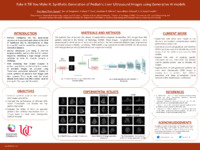Fake It Till You Make It Synthetic Generation of Pediatric Liver Ultrasound Images Using Generative Ai Models
Main Article Content
Abstract
By Phuc Nguyen, Biomedical Engineering
Advisor: Surya Prasath
Award: Excellence in Research Communication
Presentation ID: 266
Abstract: The field of artificial intelligence (AI) has seen huge advancements in recent years with extensive applications in medicine, from the diagnosis of diseases, personalized healthcare, drug discovery and medical image analysis. Its success relies on recent advances in deep learning (DL) models, a subdomain of machine learning, and the availability of high-quality biomedical datasets. However, large-scale labeled biomedical datasets that are required to train these AI models are difficult to access without collaborating with healthcare providers and obtaining patients' consent. Moreover, these datasets remain small in the medical imaging domain compared to other common DL datasets in other domains, creating a bottleneck in training viable models. Ultrasound is a medical imaging technique that utilizes sound waves for observing internal human organs. Despite ultrasound being a common imaging modality used across various medical diagnoses, large-scale ultrasound datasets tailored for training DL models are scarce. Addressing this issue, we present a method of using different models of generative adversarial networks (GANs) to generate synthetic liver ultrasound images from a limited dataset. These GANs were trained on a pediatric liver ultrasound dataset obtained from Cincinnati Children's Hospital Medical Center (CCHMC) to generate realistic liver images, which were then evaluated qualitatively by radiologists and identified as original or GAN-generated. Further, we utilized these synthetic ultrasound images to classify liver stiffness that would be useful in various liver diseases. Our work offers a promising application of GANs for other ultrasound images and enriching the already existing smaller ultrasound datasets.
